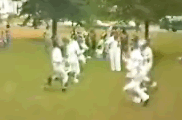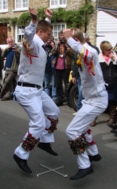
Our Tradition
The Bampton dance tradition as performed by the Traditional Bampton Morris Dancers
Although the Bampton Morris dance tradition is an ancient one, it remains a living tradition and has evolved over the decades that records have been kept. Most of the dances come from before living memory, but a few are relatively new. Often we are asked what is the proper way to do one or another Bampton dance and the answer is, “However the squire tells you to do it.” It has traditionally been the squire of the side who keeps the dance tradition alive.
The Bampton Morris dances are now performed by sides around the world and, generally speaking, they are recognisably “Bampton” though they may not be quite like we do them in Bampton. Francis Shergold, former squire of the Bampton Traditional Morris Men, once commented in an interview when asked how he felt about other sides doing Bampton Morris, “…as long as I don’t see you doing it, I don’t mind.” What he did mind was to be, “…blamed for not doing Bampton properly, ’cos somebody amateur has done it before us in the same place.”(1)
In the years before the Second World War there was considerable variation in the style of dancing, even when there was only one side. It was not until the post-war years that stylistic traditions began to be estabilished. The Arnold Woodley tradition that we dance preserves some distinctive characteristics of pre-war dancing that are not often seen in other interpretations.(2) Perhaps the most obvious is the use of a ‘cast’ hey
The current dance repertoire numbers 28 full side dances and 9 jigs. All full side dances are hanky dances. The Fool's jig uses a short stick, and the Broom dance uses, well, take a guess. Our current dances are listed at the bottom of this page.
The Music
In ancient times the Bampton dance tunes were played on the pipe and tabor (small drum) but in the mid 19th century the fiddle was introduced to the side and this was solidified by the long reign of Dick Butler as the side’s musician until the untimely demise of his instrument. Jinky Wells carried forth the fiddle tradition until he left to start his own side. Arnold Woodley
The Dress
Among the traditional Morris sides, the Bampton dress is distinctive in its formality; white trousers, white shirt worn with a Bampton necktie, and a white waistcoat. A bowler hat completes the picture. The hat is decorated with artificial flowers (stiff cloth originally) and broad ribbons of the traditional Bampton colours, red, yellow and blue. Red and yellow ribbons are worn on the sleeves. Bell pads are backed in cloth and decorated with bits of rag among the bells, giving a “fluffy” appearance. The traditional hobnail boots have been replaced by black shoes for today’s dancers.
A Whitsun (Spring Bank Holiday) Roster
Six dancers are required for the dances. In earlier times the squire selected the six best dancers from among the team for Whitsun, but today all members of the side participate, along with our musicians, some of whom are also dancers.
The Fool or Jester is believed to go back to the earliest days of Morris dancing. Besides entertaining the crowds, the Fool keeps an eye on the dancers, admonishing mistakes with a word and a whack on the backside from the bladder attached to the stick he carries. Bampton’s Fool has traditionally dressed as a circus clown.
The Sword
The last of the team was the Ragman, whose job it was to carry spare clothing and the few implements that might be used in the dancing such as the bacca pipes (churchwarden style tobacco pipes). Sadly, the trend toward self-service has reached even Bampton Morris where the availability of hold-alls, car boots, and helpful spouses has rendered this role superfluous and we have not had a Ragman in some years.
Our current dances and jigs.
Through Dances
Banbury Bill
Country Gardens
Long Willy
Rose Tree
Shepherds’ Hey
Trunkles
Webley Through
Whole Hey Dances
Shave the Donkey
Step and Fetch Her
Oddities
Nutting Girl Six Hander
Woodley Waltz
Half Hey Dances
Bobbing Around
Bonnie Green Garters
Brighton Camp
Constant Billy
Knuckledown (Flowers of Edinburgh)
Furze Field
Glorishears
Highland Mary
Jenny Lind
Johnny's So Long at the Fair
Lumps of Plum Pudding
Maid of the Mill
Old Tom of Oxford
Speed the Plough
The Forester
The Quaker
Webley Twizzle
Jigs
Bacca Pipes
Broom Dance
Flowers of Edinburgh
Fools Jig
Jogging to the Fair
Lumps of Plum Pudding
Old Tom of Oxford
Princess Royal
The Nutting Girl
Note 2: There is little point in trying ascertain which of the style variations is more 'authentic' since aspects of all traditions can be found in the very earliest films where there is what modern Morris dancers might see as a surprising amount of variation even within single dances. At least one old film appears to show both the 'cast hey' and the 'Morris hey' being used in the same dance. Written sources suggest even more variation in earlier times.
The problem is illustrated In a series video clips of conversations between noted British Morris scholar and historian, Roy Dommett and American Morris dance scholar and collector Anthony Barrand recorded while viewing B&W films. In response to questions from Barrand Dommett comments on various aspects of all three Bampton side's dancing. Visit The Digital Video Research Archive of Morris, Sword, and Clog Dancing at Boston University and search on "+bampton +dommett +barrand" for starters. (Warning: For the diehard Morris enthusiast only.)
Note 1: Graham Baldwin, 'A Canadian Experience of the English Morris'. American Morris Newsletter, 14(3), November/December 1990. (Appendix: Partial transcription of a conversation between Francis Shergold, Bampton Traditional Morris Dancers and the Vancourver Morris Men at the 'Eagle' Pub, Bampton, on June 4th, 1990. p. 30.)
Note 3: Keith Chandler, 150 Years of Fiddle Players and Morris Dancing at Bampton, Oxfordshire, Musical Traditions, No 10, Spring 1992 (Article MT051).
